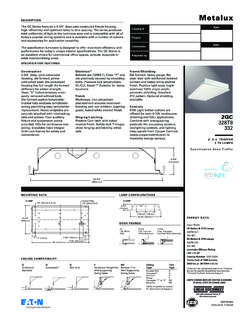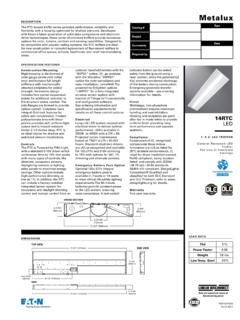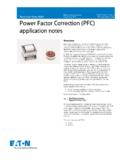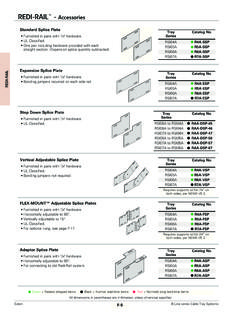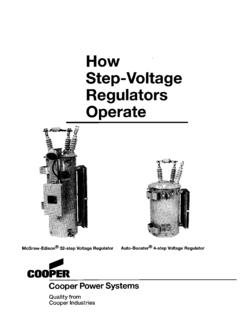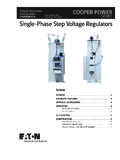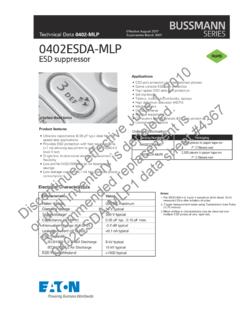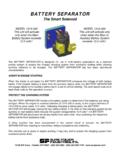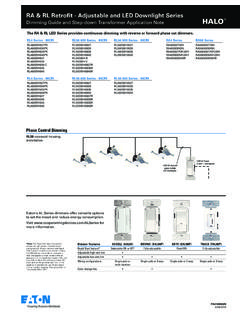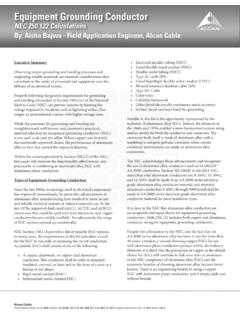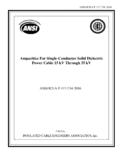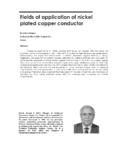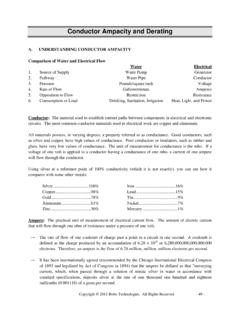Transcription of Protection of Small Conductors - Cooper Industries
1 17 2007 Cooper BussmannProtection of Small ConductorsBackgroundUp until now, 14 AWG was the smallest branch-circuit conductor allowed for general building systems use in theNEC . 2008 NEC added requirements for overcurrent Protection of 16 and 18 AWG CU insulated Conductors forpower circuits in (D). This action in itself does not permit the use of these smaller Conductors ; it provides thecriteria for the proper overcurrent Protection if other articlesof the NEC permit these smaller Conductors for the circuits/equipment covered by a given article. RequirementWhyShort-circuit currents can quickly damage insulated conduc-tors.
2 The level of damage can vary from slight insulationdamage, to annealing of the copper, to vaporization of thecopper. Under short circuit conditions the level of damagesustained is a factor of a specific insulated conductor s with-stand capability, the level of short-circuit current, and the timethe short-circuit current is permitted to flow. Smaller conduc-tors such as 16 AWG and 18 AWG have very low short cir-cuit current withstands and in many instances, the generallyacceptable overcurrent protective devices do not have theoperating characteristics to provide adequate Protection asrequired in (D) Small specifically per-mitted in (E) or (G), the overcurrent Protection shallnot exceed that required by (D)(1) through (D)(7) after anycorrection factors for ambient temperature and number ofconductors have been applied.
3 (1) 18 AWG amperes, provided all the following conditions are met:(1) Continuous loads do not exceed amperes(2) Overcurrent Protection is provided by one of the following:a. Branch-circuit rated circuit breakers listed and marked for use with 18 AWG copper wireb. Branch-circuit rated fuses listed and marked for use with 18 AWG copper wirec. Class CC, Class J, or Class T fuses(2) 16 AWG amperes, provided all the following conditions are met:(1) Continuous loads do not exceed 8 amperes(2) Overcurrent Protection is provided by one of the following:a. Branch-circuit rated circuit breakers listed and marked for use with 16 AWG copper wireb.
4 Branch-circuit rated fuses listed and marked for use with 16 AWG copper wirec. Class CC, Class J, or Class T fuses(3) 14 AWG amperes(4) 12 AWG Aluminum and Copper-Clad amperes(5) 12 AWG amperes(6) 10 AWG Aluminum and Copper-Clad Aluminum. 25 amperes(7) 10 AWG amperesProtection of Small Conductors18 2007 Cooper BussmannSmall Wire ReportIn August, 2001 there was an investigation by the Small WireWorking Group of the NFPA 79 Electrical Standard forIndustrial Machinery. The investigation focused on the pro-tection of 16 and 18 AWG CU Conductors for use in IndustrialMachinery applications and resulted in similar requirementsas (D).
5 The basis of this study compared the conductorshort-circuit current withstand to the overcurrent device let-through energy under short-circuit conditions. The SmallWire Working Group studied the critical application consider-ations for Small Conductors , proposed the requirements andconducted UL witnessed tests to prove the proposed require-ments are acceptable. After considering several damage cri-teria, the group decided to use the ICEA damage levelsbecause they were the most conservative. All other methodsallowed certain levels of damage. A testing program withinsulation damage evaluation criteria was conducted to provethe engineering analysis as valid.
6 This study determined thatsmall Conductors could be sufficiently protected by certainovercurrent protective devices, but not all the standard com-mercially available overcurrent protective devices providedacceptable levels of Protection . In this study, Class CC, J and T fuses, 30A and smaller, werefound to provide short-circuit Protection for these very current limiting characteristics of these fuses provide the necessary level of Protection under short-circuitconditions. For Class CC, J, or T fuses, the maximum short-circuit current energy permitted by UL for the 30A or lessampere ratings is below the ICEA thermal energy damagecriteria.
7 In the testing, special fuse limiters that purposelyexceed the short-circuit current I2t umbrella limits for theapplicable class fuses from UL 248 Fuse Standard were tested with 16 and 18 AWG CU insulated Conductors . Afterthe tests, the insulated Conductors were evaluated by a setcriteria including dielectric testing. The conclusion was thatClass CC, J and T 30A or less fuses protect 16 and 18 AWGCU insulated Conductors simply by complying with UL 248performance required for listing and follow-up testing. The UL 248 30A or less Class CC, J, and T fuse let-thru energylimits are less than the 16 or 18 AWG CU insulated conductor ICEA withstands.
8 See Table to Table: all commercially available UL Class CC, J, and T 30A or less fuses canprotect these Conductors from short-circuit currents. However, the actual maximumampere rating permitted for a given application is restricted by the applicable NEC requirements. As important, the study confirmed that many other overcur-rent protective devices do not provide the necessary level ofprotection. Therefore, fuses, other than Class CC, J, or Tfuses, and circuit breakers are required to be marked foruse with 16 AWG or for use with 18 AWG . In essence, thismeans other fuses and all circuit breakers are required to betested under a specific criteria for Small wire and if pass, thenlisted and marked as such.
9 UL issued a Special ServiceInvestigation, An Investigation of the use of 16 and 18 AWGC onductors for Power Branch Circuits in Industrial MachineryApplications, file number E4273 to verify the test results. Theanalysis, test program and results can also be viewed in anIEEE paper presented at the 2002 IEEE Industrial andCommercial Power Systems Technical Conference titled, AnInvestigation of the Use of 16 and 18 AWG Conductors forBranch-Circuits in Industrial Machinery Built to NFPA 792002. The report and paper can be found on 248 I2t Let-Thru LimitsCU Wire SizeShort-Circuit I2tfor 30A Class CC, J,WithstandFuses16 AWG7,344 A2s7000A2s(value for 50kA, 100kA,18 AWG18,657 A2sand 200kA)ICEA I2t Withstand Limit CU ConductorThermoplastic Insulation (75 C)Conclusion.
10 All commercially available fuses of 30A or less of these fusetypes will provide short-circuit Protection for 16 and 18 AWG CU (D) Protection of Small Conductors An Investigation of the Use of 16 and 18 AWG Conductors for Branch Circuits in Industrial Machinery Built to NFPA79 2002 Joe Schomaker Todd Lottmann Cooper Bussmann Cooper Bussmann PO Box 14460 PO Box 14460 Saint Louis.
